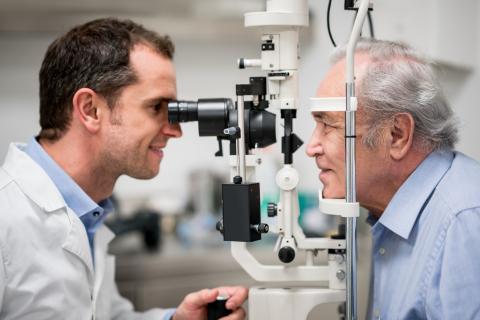Older Eyes: What’s Normal, What’s Not?
More than 142 million Americans are age 40 and older, and it is around age 40 that many people start to notice changes in their eyesight that increase as they get older. By 2030, it is predicted that more than 90 million people will be age 65 and older; one in six of these people will have vision impairment that cannot be corrected with glasses or contact lenses. For these age groups, greater awareness of common eye symptoms can help ensure quicker intervention to prevent vision loss, according to the American Academy of Ophthalmology.
In support of Healthy Aging Month in September, the Academy encouraged all adults to know what vision changes to expect and when to seek treatment for signs of a disease or condition that could cause irreversible vision loss. To aid in this understanding, the Academy is providing explanations for the following common visual changes adults may experience as they get older:
Reading a menu or sewing has become increasingly difficult. As the eye ages, its lens becomes less flexible, making it harder to read at close range or do “near work.” This condition is called presbyopia, which comes from the Greek meaning “aging eye.” Nearly all adults experience presbyopia starting around age 40. The most common treatment is simply to use reading glasses.
Eyes suddenly burn or sting and water excessively. While seemingly opposite symptoms, these both can be a sign of dry eye. Dry eye is very common as people age, especially in women undergoing hormonal changes that can alter the quality of tears the eye produces. For most people, treatment for dry eye is as simple as using over-the-counter eye drops. If these do not provide relief, an ophthalmologist—a medical doctor specializing in the diagnosis, medical and surgical treatment of eye diseases and conditions—may prescribe medication or suggest surgical options.
Seeing clouds float in front of vision or occasional flashes of light. The clouds are actually tiny clumps of cells floating in the vitreous gel, the clear gel-like fluid inside the eye, and are also called “floaters.” The flashes of light are caused by vitreous gel pulling at the retina, the light-sensitive tissue lining the back of the eye, as it moves. Floaters and flashes become more common as one ages, but a sudden increase could be a sign of a torn retina and an ophthalmologist should be seen immediately, as surgery is often a required treatment.
Colors are muted, lights appear to have halos. These can be a sign of cataracts, a clouding of the eye’s lens that nearly everyone develops as they age. Treatment for cataracts is usually surgery, which is one of the most common elective surgeries performed in the United States, and has been shown to significantly improve vision and quality of life.
Central vision seems hazy, making it difficult to recognize faces. This is a common symptom of age-related macular degeneration (AMD). Because symptoms usually aren’t noticeable until vision loss has already occurred, routine eye exams are essential to help diagnose AMD early to prevent vision loss. AMD has two forms—wet and dry. Treatment for wet AMD usually includes anti-VEGF injections—a type of drug that blocks the growth of abnormal blood vessels under the retina that cause wet AMD. At this time, dry AMD has no proven treatment, but research has shown that certain dietary supplements can help to slow its progression.
Trouble seeing at intersections while driving. Deteriorating peripheral vision may be a sign of glaucoma, a leading cause of irreversible blindness. Vision loss from glaucoma is so gradual that people affected by the condition are often unaware of it until their sight has already been compromised. Fortunately, most vision loss from glaucoma can be prevented with early detection and medical intervention, emphasizing the importance of seeing an ophthalmologist regularly, especially if a person has certain risk factors such as African or Hispanic ancestry and having migraines, diabetes or low blood pressure. The most common treatment for glaucoma is medicated eye drops.
The Academy advises that these explanations are not a substitute for medical advice. “The best course of action when encountering these symptoms is to err on the side of caution and see an ophthalmologist,” said Daniel J. Briceland, M.D., ophthalmologist and clinical spokesperson for the American Academy of Ophthalmology. “I’ve seen too many patients who have waited too long to see an eye doctor, and now they sadly face permanent vision loss.”
To ensure healthy eyes throughout life, the American Academy of Ophthalmology recommends that all adults get a baseline eye exam by age 40. In addition, the Academy recommends that adults age 65 and older have an eye exam every one to two years, or as recommended by their ophthalmologist.
Seniors who have not had a recent eye exam or for whom cost is a concern may qualify for EyeCare America, a public service program of the Foundation of the American Academy of Ophthalmology that offers eye exams and care at no out-of-pocket cost for eligible seniors age 65 and older.
